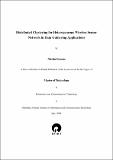Please use this identifier to cite or link to this item:
http://drsr.daiict.ac.in//handle/123456789/100| Title: | Distributed clustering for heterogeneous wireless sensor network in data gathering applications |
| Authors: | Ranjan, Prabhat Saxena, Nischal |
| Keywords: | Sensor networks Wireless communication systems Wireless sensor networks |
| Issue Date: | 2005 |
| Publisher: | Dhirubhai Ambani Institute of Information and Communication Technology |
| Citation: | Saxena, Nischal (2005). Distributed clustering for heterogeneous wireless sensor network in data gathering applications. Dhirubhai Ambani Institute of Information and Communication Technology, viii, 39 p. (Acc.No: T00063) |
| Abstract: | Wireless Sensor networks have revolutionized the paradigm of gathering and processing data in diverse environment such as, wildlife area, kindergarten or agriculture farm. The nodes in these networks usually have a very low and fixed amount of energy, which cannot easily be replenished, and hence there is a need for energy efficient techniques to improve the lifetime of such networks. Data Aggregation is one prominent method that is employed to reduce the amount of energy used in data transmission among the nodes in a network. This method requires hierarchical organization of the nodes. Clustering is one phenomenon that introduces the required hierarchy in a network. It also helps in increasing the lifetime of the network and its scalability as well. On the other hand the cost paid off for clustering is unbalanced energy consumption, which arises due to variations in the roles assigned to the nodes. This imbalance can lead to early partitioning of the network. Due to different amount of residual energy nodes cannot be considered same any more and a distinction has to be made on the basis of the residual energy and the assumption that nodes are identical has to be dropped. This work tries to address the self-organization of a wireless sensor network in presence of heterogeneity (presence of more than one type of nodes based on the energy), which may be due to initial deployment or by the network operations. The approach suggested in this work for clustering is basically meant for the data gathering applications. It is based on the local interaction of the nodes, which accounts for scalability. The nodes that are rich in residual energy are usually elected as cluster head. The load is balanced among the nodes by periodically exchanging the roles of the nodes and attaching a node to a cluster based on a cost function, which is dependent on the distance to the cluster head, degree of the cluster head and residual energy. Work also describes the simulation done to evaluate the performance of clustering and energy efficiency of the approach. |
| URI: | http://drsr.daiict.ac.in/handle/123456789/100 |
| Appears in Collections: | M Tech Dissertations |
Files in This Item:
| File | Description | Size | Format | |
|---|---|---|---|---|
| 200311030.pdf Restricted Access | 464.27 kB | Adobe PDF |  View/Open Request a copy |
Items in DSpace are protected by copyright, with all rights reserved, unless otherwise indicated.
